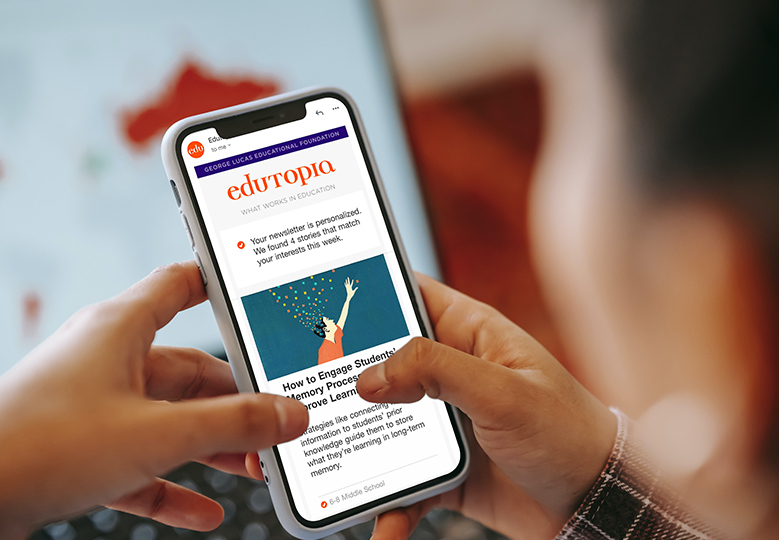
I’ve consumed many educational books written to support classroom management, technology integration, and more.
But outside of education, I’ve found titles, shared below, to support my growth as an educator, leader, and person, developing a reading practice that stimulates a new thinking space.
A NON-EDUCATION READING LIST FOR TEACHERS
1. Soundtracks: The Surprising Solution to Overthinking, by Jon Acuff
Takeaway quote: “One of the greatest mistakes you can make in life is assuming all your thoughts are true.”
So much of education connects to the refrain, “the way we’ve always done things.” But when it comes to instruction, technology, and professional development, just because we’ve always done something doesn’t mean it’s the best—that’s what Acuff reminds us.
When we get stuck in a rut, we fail to ask: How could this look different? Or we engage in self-judgment that prevents progress.
I taught writing and told myself for years that I wasn’t good at it. But as my school implemented new professional development, I found that I actually was. I canceled the old soundtrack that had played in my mind and adopted a new mindset.
EDUCATION I noticed that many students felt like they weren’t good at math or writing, but when we spent time in small groups or one-on-one and found the right supports, they discovered that they were better than they thought—and adjusted their soundtracks, too.
2. How to Work With (Almost) Anyone: Five Questions for Building the Best Possible Relationships, by Michael Bungay Stanier
Takeaway quote: “Humans are creatures of patterns and habits, and when we name something, it tells us how to navigate it.”
EDUCATION In teaching, we don’t pick our groups. We’re given students, grade levels, and content teams. This book helps us build positive working relationships—including improving those that are already strong.
EDUCATION
It includes specific tools for engaging in hard conversations in respectful, productive ways and has helped me expand my communication skills. I learned that I own as much of a relationship as the other person—and how to express needs, clear misconceptions, and respect those with whom I disagree.
Great relationships don’t just happen by chance; they take intentional work—work that students benefit from witnessing and considering, too.
3. Show Your Work! 10 Ways to Share Your Creativity and Get Discovered, by Austin Kleon
Takeaway quote: “If you want to be accepted by a community, you have to first be a good citizen of that community.”
This book provides tools to help you put yourself and your work out into the world—education to honor your comfort zone yet “show your work.”
Social media platforms—connecting with other educators—can be crucial to professional development. If you give the gift of time to other educators by letting them in on your professional process, you pay into a network and benefit, too.
Doing so has boosted my professional learning. Reading Soundtracks (above) and Show Your Work helped me realize that I have work worth sharing. I now post resources for other educators online—ones I’ve had success with in my classroom—and benefit from teachers who do the same.
4. Life in Five Senses: How Exploring the Senses Got Me Out of My Head and Into the World, by Gretchen Rubin
Takeaway quote: “Because I noticed more, I appreciated more.”
Teachers and school leaders work in stimulating spaces, but even in busy environments, we can still feel disconnected. Education can be daunting, and negativity can pull us in.
When I read this book, I challenged myself to focus on my five senses. I noticed images and sounds I’d ignored: a student yelling “I got it!” or “This is the best day ever!”; the faces of students who felt seen and heard; images I passed every week but hadn’t noticed; student work lining the halls.
This type of awareness was not a form of toxic positivity but a focus on realities right in front of me that helped to balance my days.
5. You Need a Manifesto: How to Craft Your Convictions and Put Them to Work, by Charlotte Burgess-Auburn
Takeaway quote: “Defining your manifesto will give you a clear understanding and crisp articulation of the goals you’re moving toward, the values that drive you, and the ethics that govern the boundaries of your work.”
EDUCATION
In education, we talk a lot about the “why.” But how do you break down why? How do you set criteria for yourself so that when requests come for your time, you know when to say yes and when to say no?
My manifesto, inspired by this text, states: “Lead with a coaching approach.” With this statement, as I begin conversations with teachers and students, I rely on questions and listening. This approach has led to collaboration and great discussion about thinking and learning instead of merely advice-giving. My manifesto helps me say no to things that don’t fit within my why, helping me feel tuned in to my work.
At its core, this book reminds me—and can remind us all—to put language to beliefs and values, to craft them with specific words.
6. Design for Belonging: How to Build Inclusion and Collaboration in Your Communities, by Susie Wise
Takeaway quote: “When people feel like they belong, they are able to be their best and do their best.”
Whether we are teachers or administrators, we can create spaces where others feel like they belong. This text helps us learn ways to see those we’re teaching and leading so they can perform at their highest potential.
My classroom and professional learning groups include students and adults who want to be seen, heard, and supported. This book reminds me to design activities for everyone—not just the middle.
WIDENING HORIZONS
Reading beyond educational titles has helped me grow as a professional.
I challenge you to read these titles and more to become the best all-around educator and person you can be.

